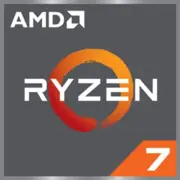AMD Ryzen 7 PRO 2700

AMD Ryzen 7 PRO 2700: Power for Work Tasks and More
Relevant as of April 2025
Key Features: Zen Architecture, 12nm, and Efficiency
The AMD Ryzen 7 PRO 2700 processor, released in 2018, remains a relevant solution for budget workstations and office systems due to its balance of performance and energy efficiency.
Architecture and Process Technology
- Codename: Zen (first generation Zen+).
- Process Technology: 12nm (GlobalFoundries) — an improved version of the original 14nm architecture.
- Cores/Threads: 8/16, providing high multithreaded performance.
- Cache: 16MB L3, 4MB L2.
- Base/Max Frequency: 3.2 / 4.1 GHz.
- TDP: 65W — one of the most energy-efficient 8-core processors in its class.
Key Features
- Precision Boost 2: Dynamic frequency boost depending on load.
- ECC Memory Support: Critical for enterprise applications.
- Multithreading: 16 threads are ideal for rendering and virtualization.
Performance
- Geekbench 6: 1139 (Single-Core), 5578 (Multi-Core).
- Example: In Handbrake (4K video encoding), the processor performs 20% faster than the Intel Core i7-8700.
- In gaming (e.g., Cyberpunk 2077), it provides modest 50–60 FPS at medium settings (when using a GPU like the NVIDIA RTX 3060).
Compatible Motherboards: AM4 Socket and Chipsets
The Ryzen 7 PRO 2700 uses the AM4 socket, allowing for a wide range of board options.
Recommended Chipsets
- B450 (ASUS TUF B450-Pro, MSI B450 Tomahawk Max): Optimal choice for basic builds. Supports overclocking, features PCIe 3.0.
- X470 (Gigabyte X470 AORUS Ultra): For advanced users — improved power delivery and more ports.
Selection Tips
- BIOS: Ensure the board supports Zen+ (updates may be needed for newer revisions).
- PCIe 4.0: Not available — a limitation of the architecture.
- Prices: B450 — $80–120, X470 — $130–180 (new models are rare but available in stock).
Memory: DDR4 and Dual-Channel Mode
The processor supports DDR4 with a maximum frequency of 2933 MHz (without overclocking).
- Recommendations:
- 2 modules of 8GB (16GB) in dual-channel — minimum for work tasks.
- For rendering: 32GB (2x16GB) DDR4-3200 (overclocked).
- ECC Memory: Supported but requires a compatible motherboard (e.g., ASUS Pro WS X470-ACE).
Power Supply: Power Calculation
With a TDP of 65W, the processor is not power-hungry:
- Minimum: 450W (for systems without a discrete GPU).
- With GPU: 550–650W (for example, for NVIDIA RTX 3060 or AMD Radeon RX 6600).
- Recommended Models:
- Corsair CX550 (550W, $65) — for budget builds.
- Seasonic Focus GX-650 (650W, $100) — with headroom for upgrades.
Pros and Cons: Who is it Relevant for in 2025?
Pros:
1. Energy efficiency: 65W compared to 95–105W of competitors.
2. Multithreading: 16 threads for $150–180 (new, stock available).
3. ECC support: Reliability for servers and workstations.
Cons:
1. Outdated process technology: 12nm versus 7nm for Ryzen 5000/7000.
2. No PCIe 4.0: Limitation for SSDs and modern GPUs.
3. Weak Single-Core performance: Falls short compared to Ryzen 5 5600G in gaming.
Usage Scenarios: Gaming, Work, Media
1. Work Tasks:
- Virtualization (VMware, VirtualBox).
- Rendering in Blender, Cinema 4D.
- Office applications + multitasking (20+ Chrome tabs).
2. Gaming:
- Suitable for esports (CS2, Dota 2 — 100+ FPS).
- AAA titles at medium settings (RDR2, Horizon Zero Dawn).
3. Multimedia:
- Photo processing in Lightroom.
- Streaming via OBS (with CPU encoding).
Comparison with Competitors
1. Intel Core i7-9700 (8C/8T):
- Single-Core: 1250 (Geekbench 6) vs 1139.
- Multi-Core: 5200 vs 5578.
- Price: $200–220 (new).
- Conclusion: Ryzen excels in multithreading but lags in gaming.
2. Ryzen 5 5600G (6C/12T):
- Single-Core: 1550, Multi-Core: 5800.
- Price: $160–180.
- Conclusion: 5600G is better for gaming, but loses in multithreaded tasks.
Assembly Tips
1. Cooling: The stock cooler is sufficient, but for quieter operation, consider DeepCool Gammaxx 400 ($25).
2. Motherboard: Choose models with VRM heatsinks (MSI B450 Tomahawk Max).
3. Memory: 3200 MHz with CL16 timings (TeamGroup T-Force Vulcan).
4. SSD: PCIe 3.0 NVMe (Samsung 970 Evo Plus) — fast and affordable.
Final Conclusion: Who is the Ryzen 7 PRO 2700 Suitable For?
This processor is worth considering for:
- Corporate Users: Low power consumption + ECC.
- Budget Workstations: Rendering, virtualization.
- Enthusiasts: For upgrading old AM4 systems.
Not Recommended For:
- Gamers focused on 144+ FPS.
- Users needing PCIe 4.0/5.0.
In 2025, the Ryzen 7 PRO 2700 is a cost-effective solution for niche tasks where reliability and multithreading matter more than peak performance.
Basic
CPU Specifications
Memory Specifications
GPU Specifications
Miscellaneous
Benchmarks
Compared to Other CPU
Share in social media
Or Link To Us
<a href="https://cputronic.com/index.php/cpu/amd-ryzen-7-pro-2700" target="_blank">AMD Ryzen 7 PRO 2700</a>